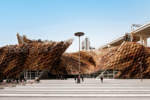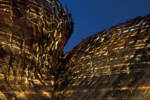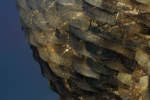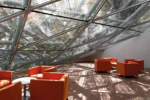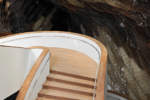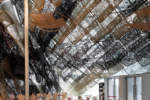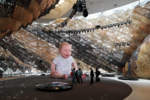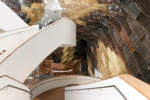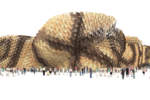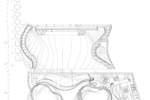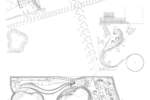architect: Benedetta Tagliabue – EMBT
location: expo 2010 shanghai - zone C
year: 2010
The Spanish Pavilion for the 2010 World Expo of Shanghai seeks to reflect upon the Spanish climate, as well as to recover the extraordinary craft of wickerwork in order to bring it back to life and to reinvent it as a new construction technique. If in the last World Expo, in Aichi (Japan), the Spanish Pavilion exhibited the colorful fantasy of the Spanish craft of ceramics, this one seeks to play with the incredible potential of wickerwork. Furthermore, wicker introduces a sustainable and ecological factor that remains present throughout the building. Basketry techniques, the handcrafts with natural fibers, are a ´global´ tradition shared by cultures of all times. Even though they vary from region to region, they occur in similar ways East and West. In this sense, the material choice for the pavilion attempts to bridge between two cultures, the Spanish (visiting) and the Chinese (the host).
The translucent quality of the weaved natural fibers inspires the creation of courtyards that, like wicker baskets, create wonderful lighting conditions that reciprocate the veiled transparencies of certain Hispanoarabic architectural elements -partial views, to watch without being watched, an ever changing game of lights and shadows- but without falling on direct interpretations of cliche. The strong light of the exterior is sieved through by superimposed steel and wicker meshes. The biggest patio of the pavillion opens to the exterior to attract and bring in the visitors. This courtyard is to the city what the backyard is to the house: a place of celebration and calm, a place to breathe. This plaza will then be a civic space for gathering. The rest of the patios remain in the ambiguous territory of the in-between – interior-exterior – where visitors can simultaneously weave in and out of these patio-basket-plazas. This pavilion pretends to escape from the single container box, defined between hybrids spaces that provide for a smooth and easy transit.
Benedetta Tagliabue was born in Milan and graduated from the University of Venice in 1989. In 1991 she joined Enric Miralles’ studio where she eventually became a partner. Her work with Miralles, whom she married, includes a number of high profile buildings and projects in Barcelona: Parque Diagonal Mar (1997-2002), Head Office Gas Natural (1999-2006) and the Market and quarter Santa Caterina (1996-2005), as well as projects across Europe, including the School of Music in Hamburg (1997-2000) and the City Hall in Utrecht (1996-2000).
In 1998, the partnership won the competition to design the new Scottish Parliament building and despite Miralles’ premature death in 2000, Tagliabue took leadership of the team as joint Project Director and the Parliament was successfully completed in 2004, winning several awards. She won the competition for the new design of Hafencity Harbor in Hamburg, Germany, for a subway train station in Naples and for the Spanish Pavilion for Expo Shanghai 2010 among others. Today under the direction of Benedetta Tagliabue the Miralles-Tagliabue-EMBT studio works with architectural projects, open spaces, urbanism, rehabilitation and exhibitions, trying to conserve the spirit of the Spanish and Italian artisan architectural studio tradition which espouses collaboration rather than specialization. Their architectural philosophy is dedicating special attention to context.



